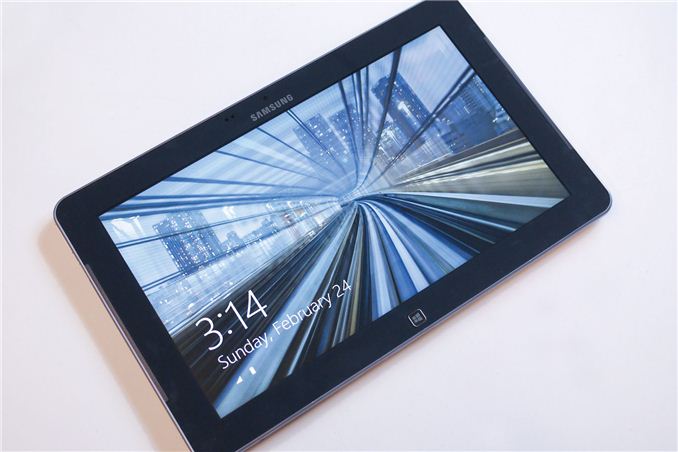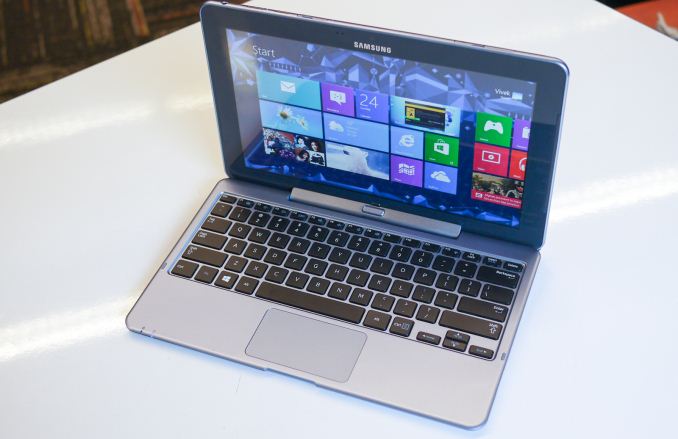Samsung ATIV Smart PC: Revisiting Clover Trail Convertibles
by Vivek Gowri on March 18, 2013 12:00 AM EST
Samsung ATIV Smart PC: Introduction
The Windows 8 tablet space at launch consisted exclusively of Tegra 3-based or Core i5/i7 ULV-based systems. That changed with the release of Krait and Clover Trail tablets like the ATIV Tab and Acer W510, respectively, but with 7W IVB and AMD Z60 on the very near horizon, we’re seeing the Windows 8 tablet market start to expand and evolve quite rapidly. After a very positive initial experience with the Windows RT slates, I was very eager to get my hands on an x86-based tablet. So when Anand gave me the chance to review one, I jumped at the opportunity.
And so we have the Samsung ATIV Smart PC, which is also known as the Samsung Series 5 Slate 500T in other parts of the world. It’s an 11.6” 1366 x 768 Clover Trail tablet that ships with Windows 8, 64GB of NAND, a laptop dock, and an MSRP of $749, and shouldn’t be confused with the more expensive ATIV Smart PC Pro (11.6” 1080p, Core i5, 128GB, Windows 8 Pro) or the no-longer-available ATIV Tab (10.1” 1366 x 768, Krait, 32GB, Windows RT). It’s pretty bad, though not quite as ridiculous as ASUS trying to make the distinction between the VivoTab (Clover Trail 11.6”), VivoTab Smart (Clover Trail 10.1”), and VivoTab RT (Tegra 3 10.1”).
Somehow, nobody has broken it to many manufacturers that the name of a product does really matter and just tacking on a suffix like RT or Smart PC means nothing if people don’t grasp the difference between them. The confusion generated by the naming schemes in use is a major factor in the somewhat lukewarm market response to many of the high profile Windows 8 devices. Part of the reason is down to the confusion generated between Windows 8, Windows RT, Metro, Modern UI, and the various other brand names used by Microsoft in relation to the latest Windows release, but the manufacturers haven’t helped things along much either. Microsoft itself can be pointed to as a culprit here as well, unless you think “Microsoft Surface with Windows RT” and “Microsoft Surface with Windows 8 Pro” roll off the tongue easily.
Nomenclature concerns aside, I was actually pretty excited to check out the ATIV Smart PC. It, along with the VivoTab TF810C, were the two slates I had marked as most interesting in my mind during the lead up to the Windows 8 launch. Clover Trail meant good battery life and x86 compatibility, the inclusion of Wacom active digitizers were exciting, and the 11.6” PLS/S-IPS displays seemed promising. The two are very comparable devices, though the ASUS is priced higher at $799, and doesn’t include the laptop dock anymore (it did at launch.) That gives the Samsung a pretty sizable price advantage, as $749 is only about $50 more than the 64GB Windows RT tablets when the keyboard accessory cost is included—more than worth it given the disparity in features and capability. This is even more true when you consider that the street price of the ATIV Smart PC has been fallen to $549 without the laptop dock or $729 with (though we've seen it at $649 at Amazon on occasion).
| Tablet Specification Comparison | ||||||||
| Samsung ATIV Tab | Apple iPad 4 | Google Nexus 10 | Microsoft Surface RT | Samsung ATIV Smart PC | ||||
| Dimensions | 10.46 x 6.62 x 0.35" | 9.5 x 7.31 x 0.37" | 10.39 x 6.99 x 0.35" | 10.81 x 6.77 x 0.37" | 11.97 x 7.46 x 0.39" | |||
| Display | 10.1-inch 1366 x 768 IPS | 9.7-inch 2048 x 1536 IPS | 10.1-inch 2560 x 1600 PLS | 10.6-inch 1366 x 768 PLS | 11.6-inch 1366 x 768 PLS | |||
| Weight | 1.26 lbs | 1.44 lbs (WiFi) | 1.33 lbs | 1.5 lbs | 1.64 lbs | |||
|
Processor
|
Qualcomm APQ8060A
|
Apple A6X
|
Samsung Exynos 5 Dual
|
NVIDIA Tegra 3
|
Intel Atom Z2760
|
|||
| Connectivity | WiFi | WiFi , Optional 4G LTE | WiFi | WiFi | WiFi , Optional 4G LTE | |||
| Memory | 2GB | 1GB | 2GB | 2GB | 2GB | |||
| Storage | 32-64GB | 16GB—128GB | 16GB or 32GB | 32GB or 64GB | 64GB | |||
| Battery | 30.0Wh | 42.5Wh | 33.75Wh | 31.5Wh | 30.0Wh | |||
| Starting Price | $499? | $499+ | $399+ | $499+ | $549 | |||
It seemed like the ATIV Smart PC would offer a good compromise between the mobility of the ARM-based slates and the power and features of the Intel Core-based ones, something aiming for the sweet spot of the Windows tablet lineup. After spending an extended amount of with it, I think it’s close, but there are some definite areas of improvement.











59 Comments
View All Comments
Krysto - Monday, March 18, 2013 - link
Why do Clover Trail devices need to be "revisited" every couple of months? Does Intel need Anandtech to do their PR for them?BrokenCrayons - Monday, March 18, 2013 - link
Though the internal hardware and performance expectations aren't going to change until there are improvements made to the silicon, the hardware package in which it resides that includes the case, screen, interface options, and battery along with other odds and ends make devices themselves worth a look. Samsung, in this case, is different with respect to build quality that is something of a shortcoming.That aside, Clover Trail is pretty uninteresting as a platform outside of putting it in the perspective of battery life. Priced at over $700, I don't personally see the appeal of what is, in essence, a netbook that costs over double the price when compared to budget-friendly systems of only a few years ago. There's just not enough benefit to offset the cost increase over a bargin bin AMD C-60 or last-gen Atom netbook for which I can simply carry an additional battery. if I want endurance as I'd be the sort to leave the keyboard dock forever attached and rarely bother to touch the screen.
Pirks - Monday, March 18, 2013 - link
Why are you lying about Clover Trail tablet prices being over $700 when in fact they start at $479?See this as a proof: http://www.newegg.com/Product/Product.aspx?Item=N8... and this too: http://www.newegg.com/Product/Product.aspx?Item=N8...
Are you a Google and/or Apple fanatic by any chance? Just curious ;)
BrokenCrayons - Tuesday, March 19, 2013 - link
From the first page of the article:"Clover Trail meant good battery life and x86 compatibility, the inclusion of Wacom active digitizers were exciting, and the 11.6” PLS/S-IPS displays seemed promising. The two are very comparable devices, though the ASUS is priced higher at $799, and doesn’t include the laptop dock anymore (it did at launch.) That gives the Samsung a pretty sizable price advantage, as $749 is only about $50 more than the 64GB Windows RT tablets when the keyboard accessory cost is included—more than worth it given the disparity in features and capability."
Death666Angel - Tuesday, March 19, 2013 - link
You realize that you are talking about all Clover Trail tablets, while Vivek just talks about 2 very specific, premium products? If you don't need a keyboard dock and an active digitizer, you can get Clover Trail tablets much cheaper. And in turn, if you need a keyboard dock and especially an active digitizer, comparing that price with old netbooks is useless, as they are useless for that specific need.BrokenCrayons - Tuesday, March 19, 2013 - link
The scope of my original post and response do not encompass, as you imply, "all Clover Trail tablets" outside of considerations of overall platform performance. The majority of the discourse concerns the Samsung tablet in specific and its various shortcomings relative to the MSRP under consideration of the benefits offered in exchange for the costs.With regards to my needs for a various features such as an active digitizer, I've already mentioned that previously. "I'd be the sort to leave the keyboard dock forever attached and rarely bother to touch the screen." In light of my own usage model and requirements, the price of the Samsung isn't justified or reasonable when one can acquire similar performance from low cost hardware available at office supply stores.
http://www.officedepot.com/a/products/592409/Acer-...
Understandably, your personal preferences and desires for a computing platform might be different. That's perfectly reasonable, but the mold which suits your needs may not be universally applied to others.
Death666Angel - Tuesday, March 19, 2013 - link
Then you should amend that sentence:"That aside, Clover Trail is pretty uninteresting as a platform outside of putting it in the perspective of battery life. Priced at over $700, I don't personally see the appeal of what is, in essence, a netbook that costs over double the price when compared to budget-friendly systems of only a few years ago."
As you make no effort to distinguish between different CT platforms. And when you get called out for it, you quote the article which just mentions 2 examples.
duploxxx - Monday, March 18, 2013 - link
typical OEM behavior, go with the flow i.s.o. design to differentiate. There has always been a netbook atom killer called Brazos, same for the tablet space it exists, http://www.anandtech.com/show/6672/vizio-tablet-pc... no slugish gui or impossible 3d like on the clovers, i had many tabs in house for testing, just makes the all day experience horrible. from an smooth workable gui experience (swiping between screens, switching applications) on tablets: IOS > ANDROID = AMD Soc >>>>> Clover this is how you can rate the experience.nerd1 - Monday, March 18, 2013 - link
I don't care about UI experience, I do care about the active digitizer (for inking) and battery life.DanNeely - Monday, March 18, 2013 - link
The part of the Asus device chaos that's annoying me the most is that from what I can tell from their webpage; their 10" atom model is only available with a wireless keyboard and a cover that can be folded up to let the two imitate a laptop on a table while the winRT model has an actual keyboard dock with the extended battery and ability to use like a laptop even if a perfectly flat surface isn't available. The atom tablet and keydock would otherwise match what I am looking for almost perfectly.